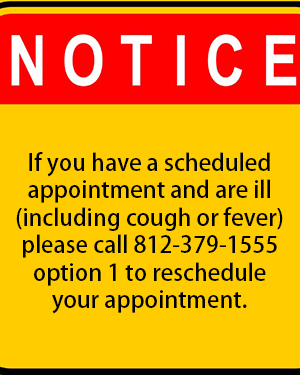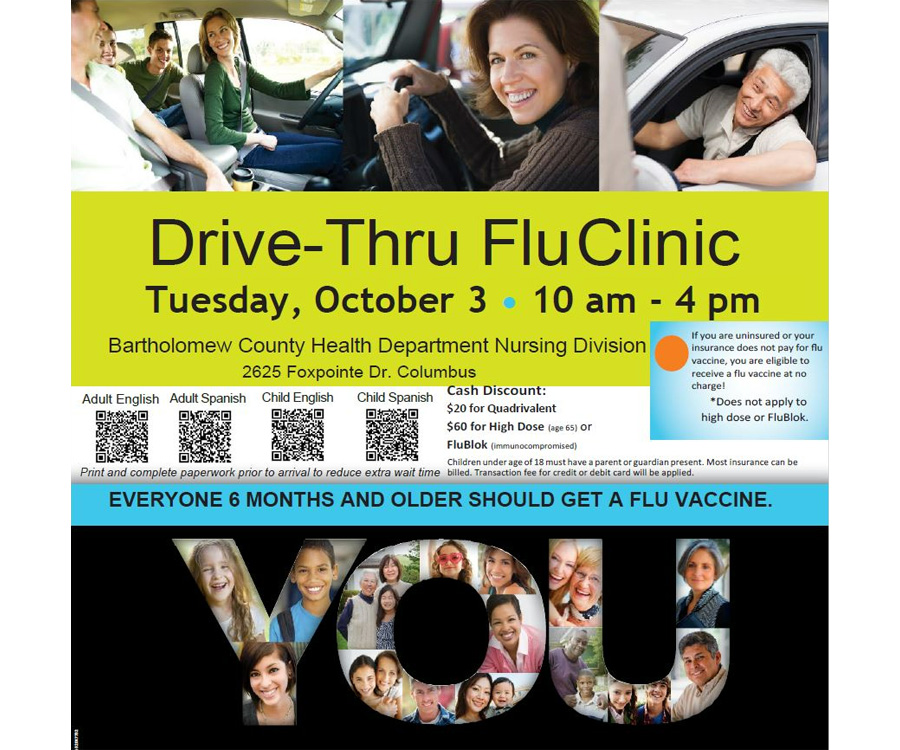About Us
 |
Through prevention, education and preparedness the Bartholomew County Health Department supports the residents of the county as they pursue healthy living for themselves, their families and neighbors in the community. The specific duties of the health department are defined by IC 16-20-1 and IC 16-20-8.
The Bartholomew County Health Department supports the residents of Bartholomew County in: disease prevention, health education, vital records, environmental health, and public health preparedness.
The Bartholomew County Health Department is divided into four divisions:
- Environmental Health
- Public Health Nursing *Now accepting debit and credit cards for provided services.
- Public Health Preparedness
- Vital Records
Management Staff
Director of Nursing: Amanda Organist; BSN, RN
Services
Clinics
- Immunization Program/Clinic: Focuses on providing clients with immunity against specific diseases. Immunizations against vaccine preventable diseases for infants, children, and adults are available. Immunization clinic for infants and children through 4 years of age is held every Thursday by appointment. Immunization clinic for children 5 through 18 years of age and adults is held every Monday and Tuesday by appointment. A record of previous immunizations, faxed from a doctor's office, is required for children eighteen (18) and under. All children under the age of eighteen (18) must be accompanied by a parent or guardian.
- Sexually Transmitted Disease (STD) Program/Clinic: Services include Sexually Transmitted Disease Screening, diagnosis, treatment, and risk reduction counseling. The STD Clinic is held every Tuesday and Wednesday by appointment. All counseling and provider referral services are confidential. Assistance can be provided to minors, 13 years and older, without parental consent.
- HIV Counseling and Testing: Clients are seen anonymously or confidentially by confirmed appointment. HIV/AIDS education is tailored to address each individual's risk factors for HIV infection. An appointment may last 30-60 minutes. No charge.
- Tuberculosis (TB): Maintains a surveillance system and TB case registry to ensure prompt reporting. Tuberculin skin testing is available by appointment. The cost is $10.00. The QuantiFERON Gold TB Blood test is also available for $20. Please call to schedule an appointment for this test. TB medicine (provided by the ISDH) is dispensed when ordered by the client's doctor. Clients are seen on a monthly basis by a RN for an evaluation regarding medication compliance and potential side effects.
Reports
- Communicable Disease Investigation prevents epidemics and the spread of disease. Communicable disease reporting can initiate from laboratories, hospitals, doctors' offices, and other health departments. Surveillance and investigation activities involve communicating with the infected individual, his/her contacts and medical care provider(s). Mandated Reports are filed with Indiana State Department of Health (ISDH).
Screening/Tests
- Blood sugar/Total cholesterol Screening Clinics: Clinics are held on 2nd Tuesday of the month. Call for an appointment.
- Lead Testing: Available for children 0-6 years of age by appointment. Childhood lead poisoning is a major, preventable environmental health problem in the U.S. High lead levels can cause major health and educational problems.
- Pregnancy Testing: Available by appointment at no charge.
Programs
- MyVaxIndiana: MyVaxIndiana provides acces to immunization records anytime, anywhere around the world with a PIN. Individuals can be registered at the health department and receive their PIN. An email address is required.
- Sharps Program: Sharp containers are made available and disposed of at no cost to Bartholomew County residents. A prescription from the physician showing the need for a container is required on the first visit, the full container is then returned to the Bartholomew County Health Nursing and a new one is issued. The returned container must be issued by the Bartholomew County Health Department.
- Prenatal vitamin program: Prescription strength prenatal vitamins are available for duration of pregnancy at no charge. Appointment is required
Scheduled Clinics
Regularly Scheduled Clinics
Nursing Clinics |
Times |
|
Adolescent/Adult Immunization Clinic |
Monday and Tuesday by Appointment. |
|
Infant through 6 years Immunization Clinic |
Thursday by Appointment |
|
STD/HIV/Hepatitis Clinic |
Tuesday and Wednesday by Appointment |
|
Lipid Profile and A1C Screenings |
Second (2nd) Tuesday of the month on alternating months. Please call to confirm testing schedule and to make an appointment. |
|
TB Testing |
Every Monday walk in 8am-11am and 1pm - 4pm. Call prior to coming to confirm dates and times. |
|
|
|
Head Lice
Head Lice (Pediculosis)
The Bartholomew County Health Department (BCHD) follows the Centers for Disease Control and Prevention (CDC) recommendations for diagnosing and treating head lice. Having head lice is very common; as many as 6-12 million people worldwide have head lice every year. Anyone who comes into close direct contact with someone who already had head lice, contaminated clothing, other belongings is at risk for getting head lice. The population greatest at risk tends to be children ages 3-10 years and their families.
Proper Diagnosis
Lice are diagnosed by looking closely through the hair and scalp for nits, nymphs, or adults. Finding an adult or nymph may be a difficult task; there are usually few of them and they can move quickly. According to CDC, if live lice are not seen, finding nits closer than ¼" from the scalp confirms a person is infested. However, if a nit is more than ¼" from the scalp the infestation is an old one. The rationale for this is that the adult female louse lays her eggs at the base of the hair shaft, and the eggs and lice need to maintain a consistent temperature. As the hair grows, the nits that are at the base of the hair shaft cannot maintain a constant temperature. Generally, hair grows ¼" per week. The optimal temperature for louse survival happens to be the temperature that is maintained on top of heads. If one is not sure if a person has head lice, a health care provider, the local health department, or school nurse should make the diagnosis. In many cases, a child may be said to have a nit infestation, but when the nit is sent to the lab it is actually dandruff, hair spray droplets or some other particle. Therefore, a proper diagnosis is important before treatment is administered. Often, children are sent home from school and parents unnecessarily take time off work because of an improper diagnosis.
Clinical Treatment
Treating head lice correctly has many steps which must be thoroughly completed to avoid being unnecessarily re-infested. If children less than 2 years old have an infestation, contact your doctor. After a correct diagnosis of head lice, the individuals should remove the clothing and apply the lice medication according to the label instructions. Clothing should immediately be washed with soap and hot water. DO NOT use a crème rinse or combination shampoo/conditioner before using the lice medication. At the present time, the BCHS recommends Sklice as a treatement for lice. A prescription for Sklice can be otained at teh BCHD; coupons are also avalaible. The infested person should then put on clean clothing after treatment. Is some live lice are found 8-12 hours after treatment, but are moving slower than before, do not retreat. Comb dead and remaining live lice out of hair with a lice or flea comb. If no dead lice are found or the lice seem as active before within 8-12 hours after treatment, the medication may not be working. Patients should see a doctor for a different medication and follow the treatment instructions. After treatment, comb and remove all nits from the head every 2-3 days to check for the presence or absence of lice or nits. Retreat with medication 7-10 days after original treatment if there is a live infestation. It is a common practice to have to perform at lease two treatments to get rid of head lice. DO NOT retreat more than 3 times, and do not mix lice medications. If there are other family members who are not currently infested, DO NOT treat other family members until there is confirmation of an infestation. However, their heads should be checked every 2-3 days until the infested person is clear of lice and nits.
Environmental Household Treatment
All washable clothing and bed liners in contact with the infested person two days prior to treatment should be washed in hot soapy water (130 F). Dry the laundry using the hot cycle for at least 20 minutes. Clothing that the infested person directly touched for two days prior, which are not washable, should be dry-cleaned. All clothing, stuffed two days prior, which are not washable, should be dry-cleaned. All clothing, stuffed animals, comforters, and other items that cannot be washed or dry-cleaned need to be placed in a plastic bag and sealed for one week. All combs, brushes and other hair accessories, should be washed with hot soapy water and soaked for 1 hour in rubbing alcohol. Lice can temporarily live on carpet, car seats, and upholstery, which should be thoroughly vacuumed. It is not necessary to spray insecticide or lice spray to these surfaces because they can be toxic if inhaled. Vacuuming these areas is just as effective and a lot less expensive and safer. Pets should not be treated for head lice because lice only live on humans.
Fees
Screenings |
Price* |
|
TB Skin Test (Administer and read) |
$10 |
|
TB skin test reading only (for test administered elsewhere) |
$2 |
|
QuantiFERON TB Gold Blood Test |
$25 |
|
Blood work (Lipid Profile), A1C |
Call for fee |
|
Chlamydia Testing |
Based on qualifiers. Call for fee |
|
Gonorrhea Testing |
Based on qualifiers. Call for fee |
|
Lead Testing in Children, ages 6 and below |
No Cost |
|
Administration fee for all screenings |
At insurance pay rate |
Vaccines |
Price* |
|
Pediatric Vaccines: Children who qualify for the VFC (Vaccine for Children) program^ |
No Cost |
|
Pediatric Vaccines: Insured children and those who do not qualify for the VFC^ program |
At insurance pay rate |
|
Adult Vaccines |
At insurance pay rate** |
|
Administration fee (Adults and children who do not qualify for the VFC program) |
At insurance pay rate |
|
^ The Vaccine for Children (VFC) program provides vaccines at no cost to children whose families may not be able to afford vaccinations * Now accepting debit and credit cards for provided services through Public Health Nursing. All charges made through debit or credit are subject to percentage based transaction fees. ** May qualify for State funding |
|



